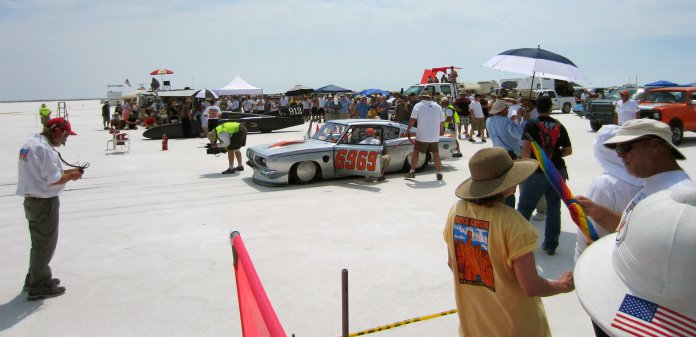SEMA and FIVA share news about progress being made at Bonneville and with the potential for keeping classic cars on future roads.
Thanks to a public-private effort, the Specialty Equipment Market Association reports the installation of a new water well and new weather and hydrologic equipment for measuring salt growth conditions as part of its broader Restore Bonneville program.
SEMA reports “Federal and state funds were released last year to install the monitoring equipment and help increase the volume of salt pumped onto the Bonneville Salt Flats this year to a total of up to 500,000 tons.
“As part of the Restore Bonneville program, SEMA and the racing community joined forces with the U.S. Bureau of Land Management (BLM), Utah Department of Natural Resources (DNR), Utah Geological Survey (UGS), and Intrepid Potash Inc. in the collaborative restoration effort,” SEMA added.
SEMA notes that in the 1960s, the land-speed racing venue stretched more than 13 miles, but recently had shrunk to 8 miles or even less while the overall Salt Flats had been reduced from 96,000 acres to 30,000.
Racing on the Salt Flats in northwest Utah date to 1914.
“Bonneville serves another important role as a crucial natural resource for potash used primarily in fertilizers,” SEMA added in its statement. “To obtain potash, salt brine is collected in large solar evaporation ponds, from which potash is separated out and processed. The remaining salt is stored and may then be returned to the Salt Flats as salt brine.
“Beginning in the 1960s, the BLM issued leases to the north of Interstate 80, where motorsports racing and other recreational activities take place, allowing salt brine to be collected in open ditches for commercial potash processing. The mine operator began pumping the processed salt back onto Bonneville in 1997 as a result of a pilot project SEMA advocated to create. The Restore Bonneville program will help address salt losses that occurred before 1997, when the potash project was operated by previous companies.
“The BLM and DNR signed a Memorandum of Understanding in April 2020 to jointly pursue restoration efforts. The program, which SEMA calls Restore Bonneville, will be managed by DNR, in conjunction with the BLM, and operated by Intrepid Potash. The endeavor is strongly supported by SEMA and the Save the Salt Coalition, a collection of companies, organizations, individuals, and land speed racing teams.
“Stakeholders are now identifying projects to be pursued in 2022 and beyond to continue increasing the volume of salt being pumped,” SEMA added. “While the bulk of the program funding will come from federal and state appropriations, both industry and the land-speed-racing community will voluntarily help pay the costs.”
Meanwhile, from Europe comes word that vintage vehicles will continue to be viable on the roads of the future if the voice of the Fédération Internationale des Véhicules Anciens is taken seriously now that FIVA has been granted “consultative status” by the Economic and Social Council of the United Nations, which is charged with moderating the debate about sustainable development.
“This is great news for enthusiasts around the world,” FIVA president Tiddo Bresters is quoted in the group’s news release.
“Behind the scenes, FIVA works ceaselessly to ensure that policymakers understand the cultural value of historic vehicles, which are all too easily overlooked as the world embraces a greener future. Now that the United Nations has acknowledged the international importance of historic vehicles in this way, our voice will be that much louder.
“We need to ensure that regulators appreciate the cultural contribution of historic vehicles, and the very specific needs of their owners, drivers and the community that flourishes around them.”





